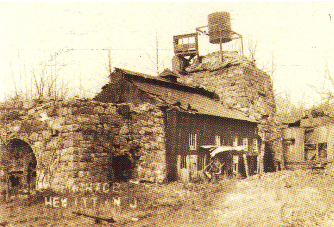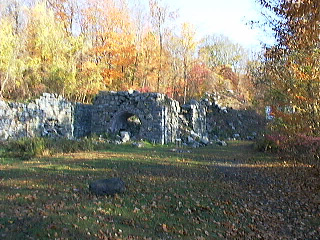 |
|
|
|
(The Gun Metal Furnace) |
||
|
|
|
|
The stone wall along the back side (left side in
the image shown below at right) is a retaining wall against the furnace
bank. We are about 100 feet and 100 years from the Revolutionary War
period furnace and now we are standing before the new furnace built
by Hewitt and Cooper Company at the outbreak of the American Civil War.
Originally, this furnace stood over 60 feet high,
more than twice the size of the Colonial furnace and it had almost twice
the output. A high quality gun metal was processed here; in fact the
furnace became known as the Gun Metal Furnace. Mr. Hewitt was a major
supplier of gun metal to the Union Army and so contributed to the North's
important industrial advantage over the Confederacy. By the close of
the war, a second furnace was built a few feet away and the two were
connected by a large three story casting house (see left image below).
The top part of the furnace was later
removed in preparation for conversion to running on
anthracite coal instead of
charcoal.
This process was never completed on this furnace, but it was
completed on the second furnace which ran for the last 10
years of its operation as a coal furnace.
A charcoal furnace burned so hot that there was
no smoke to speak of, they actually burned clean. The later steel process
developed in Pennsylvania involved the making of coke
fuel from coal which released all kinds of nasty smoky pollutants damaging
much of the environment in Pennsylvania.
Ore Roasters Today, only the foundation remains of the
wooden casting house and, on the other side, the overgrown
giant mound is the second furnace - named Lucy - built in
the 1860s. Lucy was the last furnace to operate here, and
went out of blast in 1882 after a hasty relining job caused
gases to escape and flames to engulf the furnace. (Iron
furnaces were often given a feminine name.) She was rebuilt
but the economy had shifted and iron making was now cheaper
nearer the coal fields of Pennsylvania. This was one of the
last iron making operations here in the Highlands, although
you can see many remains throughout these hills.
According to local legend, now discounted, Lucy met a
peculiar demise. The story was that in 1917 a rather famous silent movie maker
came here to Long Pond and began filming. Apparently it was to have been
a rather racy movie with naked ladies around the waterfall
but in any case, for special effects, dynamite was planted
in one of Lucy's arches and she was blown up. Despite extensive research by many, no documentation of any such film, or explosion, has een found.


To the left of the Gun Metal
Furnace, built into the retaining wall, is evidence of
another hearth. This was an iron ore roaster where ores were
heated prior to charging the furnace. It was discovered
early on that pre-roasting the ore removed some of the
sulfurs and other undesirable impurities, making for a
better finished product.


